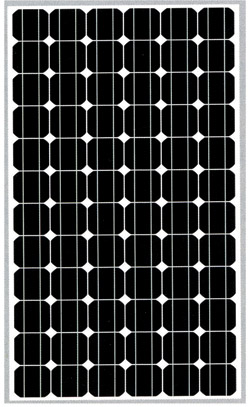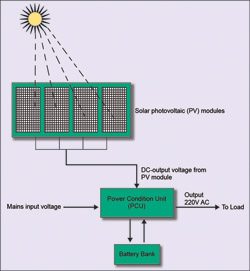‘Solar’ is the Latin word for ‘sun.’ Solar energy from sun gives life to earth and its creation. Besides this, solar energy can also be successfully utilised for various applications such as cooking, heating, drying, lighting, power generation, communication, space technology, etc. Our country is blessed with abundant sunlight, which is a very large resource for development of solar photovoltaics (PV) power. There is no negative impact on the environment with utilisation of this power and it is freely available. Also, it is the safest renewable energy resource available in the world.



Solar cells, commonly called as PV cells, convert sunlight directly into electricity. The name PV is derived from the process of converting light (photons) into electricity (voltage). This is called the ‘PV effect.’ The PV effect was discovered in 1954 by the scientists at Bell Telephone Company. They discovered that silicon (an element found in sand) creates an electric charge when it is exposed to sunlight. Since then, these solar cells have been used to operate smaller devices like calculators, watches, lights, etc and also large aircraft and space satellites. In the present day, thousands and thousands of people power their houses, business establishments, manufacturing units, etc with solar PV systems.
In a solar-energy system, the most important component is a solar or PV cell. This is a solid-state device with a large light-sensitive area that converts the light energy from the sun directly into electricity by the PV effect. To increase the power, a number of individual PV cells are interconnected in a weatherproof sealed package called a PV module or a solar panel. Solar cells are very brittle and require great care and protection whilst handling. To protect them from damage, they are hermetically sealed between top layer of glass or transparent plastic and the bottom layer is protected with plastic sheet or a combination of metal and plastic. To increase the strength of the solar panel, the outer edge assembly is kept in a metal frame all the time.
A junction box is fixed at the bottom side of solar panel to interconnect and take the output voltage. A mounting frame made in metal is used to assemble these solar panels which are connected in parallel or a series combination as per requirement of the voltage and current.
Solar-home system
A solar-home system consists of a solar PV module, a battery bank and a power-conditioning unit (PCU). The output voltage from the PCU can operate light, fan, TV, computer, home appliances, etc depending on the capacity of the system.
Solar PV module generates DC voltage in proportion to solar panel size and the available sunlight. The power generated in the PV module is sent to the charge control circuit in the PCU. The charge control circuit controls the voltage and current and sends these to the battery bank to charge the battery. The inverter in the PCU processes the 12-24V DC voltage into the required output voltage of 220V AC at 50Hz, which is connected to the load.
The system has a microcontroller-based pulse width modulation (PWM) charge controller which can control the charging current. When the solar energy from the solar panel is available, the mains power will not be used for battery charging or for the load. The load takes power from the solar panel. Power from the mains will be used only when the battery voltage is below the preset voltage (this voltage can be preset). When mains power is on, mains supply and power from the solar unit does not load each other. The charging is carried out with the intelligently-shared current.
An important fact is that if the PCU gets overloaded whilst working on solar, the load gets shifted to mains supply automatically and again when the battery charge reaches the preset level, mains supply is cut off and the load gets shifted to solar/battery again. Battery deep discharge, overcharge protections are incorporated inside the PCU. This ensures health of battery thereby extending its life.
Solar water-pumping system
Soalr water-pumping system is specifically designed to pump water in areas where there is no reliable supply of electricity. The system is used to pump water for domestic use, agricultural irrigation, aquaculture industry, water treatment, etc.


Solar water-pumping system comprises a set of solar PV modules. The PV modules absorb sunlight energy and generate required level of DC voltage and current in proportion to the solar PV modules and available sunlight. The DC output voltage produced by the PV modules is sent to the pump control unit. The pump control unit processes the DC voltage into required levels of three-phase/one-phase AC voltage for the operation of the pumping system. Drive circuits are also integrated in the pump control unit, so no other additional devices are required either to start or run the motor. The system is also equipped with protection circuits to work against low voltage, overvoltage, overcurrent, overheat, etc.






